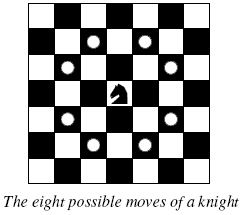这道题目关键的就是字典序(题目要求字母要尽量小其次数字要尽量小,所以就是按照左上、右上、左下、右下的顺序)这就需要dir数组要有一个固定的顺序,还有就是输入时是先输入列再输入行
Description
 Background
Background
The knight is getting bored of seeing the same black and white squares again and again and has decided to make a journey
around the world. Whenever a knight moves, it is two squares in one direction and one square perpendicular to this. The world of a knight is the chessboard he is living on. Our knight lives on a chessboard that has a smaller area than a regular 8 * 8 board, but it is still rectangular. Can you help this adventurous knight to make travel plans?
Problem
Find a path such that the knight visits every square once. The knight can start and end on any square of the board.
Input
The input begins with a positive integer n in the first line. The following lines contain n test cases. Each test case consists of a single line with two positive integers p and q, such that 1 <= p * q <= 26. This represents a p * q chessboard, where p describes how many different square numbers 1, . . . , p exist, q describes how many different square letters exist. These are the first q letters of the Latin alphabet: A, . . .
Output
The output for every scenario begins with a line containing "Scenario #i:", where i is the number of the scenario starting at 1. Then print a single line containing the lexicographically first path that visits all squares of the chessboard with knight moves followed by an empty line. The path should be given on a single line by concatenating the names of the visited squares. Each square name consists of a capital letter followed by a number.
If no such path exist, you should output impossible on a single line.
If no such path exist, you should output impossible on a single line.
Sample Input
3 1 1 2 3 4 3
Sample Output
Scenario #1: A1 Scenario #2: impossible Scenario #3: A1B3C1A2B4C2A3B1C3A4B2C4
#include <stdio.h>
#include <string.h>
int go[8][2]= {{-1,-2},{1,-2},{-2,-1},{2,-1},{-2,1},{2,1},{-1,2},{1,2}};
int vis[30][30];
int n,m,flag;
struct node
{
int x,y;
} a[30];
void dfs(int x,int y,int step)
{
a[step].x=x,a[step].y=y;
if(step==n*m)
{
for(int i=1; i<=step; i++)
printf("%c%d",a[i].y-1+'A',a[i].x);
printf("\n");
flag=1;
}
if(flag)return;
for(int i=0; i<8; i++)
{
int xx=x+go[i][0];
int yy=y+go[i][1];
if(xx>0&&xx<=n&&yy>0&&yy<=m&&vis[xx][yy]==0)
{
vis[xx][yy]=1;
dfs(xx,yy,step+1);
vis[xx][yy]=0;
}
}
}
int main()
{
int t,ci=1;
scanf("%d",&t);
while(t--)
{
memset(vis,0,sizeof(vis));
flag=0;
scanf("%d%d",&n,&m);
printf("Scenario #%d:\n",ci++);
vis[1][1]=1;
dfs(1,1,1);
if(flag==0)
printf("impossible\n");
printf("\n");
}
return 0;
} 





















 799
799

 被折叠的 条评论
为什么被折叠?
被折叠的 条评论
为什么被折叠?








